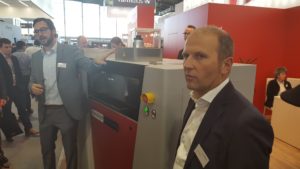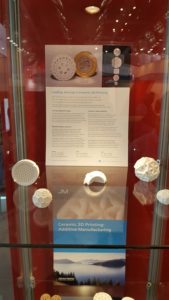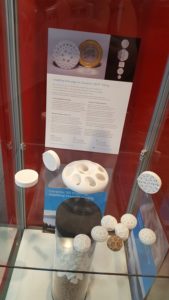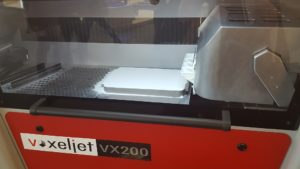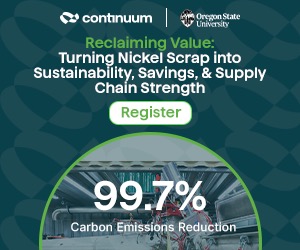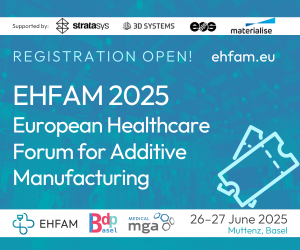 During the first day of formnext 2017, Germany-based voxeljet presented its newest 3D printing system in a well-attended press conference as its first proprietary High Speed Sintering machine was officially unveiled. Designed to complement the company’s portfolio of binder jetting technologies and advance 3D printing toward realizable production applications, High Speed Sintering (HSS) drew quite a crowd to the new VX200 HSS 3D printer. Additionally new for the company was the introduction of a modified version of its existing PolyPor processes used for making investment casting patterns with PolyPor C2 (PPC²), an advanced PMMA material process for plastic 3D printing. The company took the opportunity as well to elaborate on views toward materials development, partnerships, facilities, and vision.
During the first day of formnext 2017, Germany-based voxeljet presented its newest 3D printing system in a well-attended press conference as its first proprietary High Speed Sintering machine was officially unveiled. Designed to complement the company’s portfolio of binder jetting technologies and advance 3D printing toward realizable production applications, High Speed Sintering (HSS) drew quite a crowd to the new VX200 HSS 3D printer. Additionally new for the company was the introduction of a modified version of its existing PolyPor processes used for making investment casting patterns with PolyPor C2 (PPC²), an advanced PMMA material process for plastic 3D printing. The company took the opportunity as well to elaborate on views toward materials development, partnerships, facilities, and vision.
“We are wide open for new materials; the purpose is to develop new materials, our own material sets,” Tobias King, the company’s Director Marketing & Applications, explained. “We thought it was a good idea to present [the VX200 HSS] here first before, in a year or so, a production system.”
King noted that the company has begun work with PA-12, and is working with partner Evonik toward the development of a TPU material. He continued, noting that the system has been set up in the company’s UK facility, where the team find it “relatively easy to operate.” The forthcoming production system based on this technology will, he said, “be bigger and faster.”
“This is a similar process to HP — the big difference is we have no detailing agent. There is one ink only; heat management means there is no need for that agent. This is laying down a powder, which is different from XJet; they are not the competition,” King said of market comparisons being made.
Advantages to voxeljet’s system include resolution (noted as being 600 DPI) and geometric freedom, as King and CEO Dr. Ingo Ederer noted. Said to combine the benefits of binder jetting and selective laser sintering (SLS) technologies, HSS additionally brings open materials capabilities. The VX200 system can work with different types of powder, with an average grain size of 30 – 70 µm, for layer thicknesses varying between 80 and 100 µm.
Featured at the voxeljet booth was UK-based chemical giant Johnson Matthey, which has been increasing its focus on — and its presence in — ceramics 3D printing. The two companies are collaborating on further development of ceramic binder jetting, with an eye toward a larger-scale future for developments. Johnson Matthey (JM) began its work in this area with development of next-generation catalytic solutions and is now working in applications ranging from electrical insulating to aerospace to medical.
So much information was presented during the press conference that I came back the next day to find out more directly from voxeljet Managing Director James Reeves. We started from the beginning:
“voxeljet was established in 1999, which is quite well established for a 3D printing company,” Reeves told me.
Looking toward the company’s well-known work with binder jetting technologies, we discussed applications in investment casting. Materials play a big role, of course, in considerations here, and voxeljet technologies can work with materials from sand — “This is the same for foundries as they’d get otherwise; here it just happens to be 3D printed” — to more recent work with PMMA. Further keeping materials familiar to users, Reeves noted that HSS can use Nylon 12, a powder familiar to those working with SLS 3D printing technologies, and allowing for users to “compare like for like.”
“HSS is a licensed technology, adding to our knowledge of binder jetting,” Reeves said. “The VX200 is an R&D machine. We are collaborating now on materials. Once we have the production system, this will be open as well — truly open materials.”
The company is keeping focused to its areas of expertise, which, while expanding, are targeted. Reeves noted that voxeljet is “not looking to take the whole market in terms of providing materials and machines.” Working at an intentional, steady pace toward development of its production machine, voxeljet is keen to underscore the R&D nature of the VX200 HSS system.
“For us, the VX200 is a toy meant for R&D; compare it to the huge 800 system. This system is really good for a development company; it takes a thermal image every layer, so you can change parameters as needed as you go. It all helps in application and material development,” Reeves explained.
“The feedback we expect will help for production development. It’s what you would expect from voxeljet: high productivity meant for factories, not just labs.”
 Returning to the market comparisons raised previously, Reeves noted that “The big question is: how different is this from HP’s technology?” Referencing Multi Jet Fusion technology, HP’s proprietary 3D printing technology in its Jet Fusion systems, Reeves acknowledged that, yes, “It is similar to MJF.” The process using infrared is similar, as is the start with Nylon 12 material, which was the first to be available for use on MJF systems. Notably, Evonik has also been a collaborative materials partner for both companies. However, HSS is distinct from MJF in several technological matters, such as the lack of detailing agent previously noted, as well as in the approach each company is taking to market. While HP is known for its open materials system, powders for use in Jet Fusion 3D printers should still be certified by HP through a step-by-step process including approval from HP’s labs. When voxeljet says ‘open materials,’ they mean it much more broadly. Further differentiating factors lie in the companies’ approaches to market, as voxeljet is not currently looking to sell production machines.
Returning to the market comparisons raised previously, Reeves noted that “The big question is: how different is this from HP’s technology?” Referencing Multi Jet Fusion technology, HP’s proprietary 3D printing technology in its Jet Fusion systems, Reeves acknowledged that, yes, “It is similar to MJF.” The process using infrared is similar, as is the start with Nylon 12 material, which was the first to be available for use on MJF systems. Notably, Evonik has also been a collaborative materials partner for both companies. However, HSS is distinct from MJF in several technological matters, such as the lack of detailing agent previously noted, as well as in the approach each company is taking to market. While HP is known for its open materials system, powders for use in Jet Fusion 3D printers should still be certified by HP through a step-by-step process including approval from HP’s labs. When voxeljet says ‘open materials,’ they mean it much more broadly. Further differentiating factors lie in the companies’ approaches to market, as voxeljet is not currently looking to sell production machines.
“We are looking for collaborators, not customers,” Reeves told me. “We’re very keen to speak to end users to inform development. The end game would be to take on SLS, and eventually injection molding.”
As voxeljet continues to reach toward its ambitious goals in production, keeping that end game in sight is important for building both process and strategy. The automotive industry represents an important vertical for voxeljet’s technology, and a target for production volumes via 3D printing.
“I think we will be one of the first to reach production volume for automotive, starting with sand, and eventually with HSS,” Reeves explained.
“We’re keen to talk to automotive; not just their additive manufacturing teams, but their manufacturing departments. We want to find out what they need, what their actual throughput is, what their real needs are. We’re not just trying to sell machines, we’re trying to meet needs.”
At formnext, the voxeljet booth was regularly packed with intrigued visitors. There was “a lot of interest,” Reeves said, in HSS, work with PMMA, and ceramics work with Johnson Matthey.
“We have this core competence working with different powders. Johnson Matthey’s powder is very hard to feed. It doesn’t flow well — you can make a snowball out of it — and we’ve made it work reliably,” he said.
 Building on its years of experience, voxeljet is looking to enhance aspects of working with difficult powders, looking at powder feeding, post-processing, and granule size; “These are things we’ve done for years,” Reeves said of the team’s expertise.
Building on its years of experience, voxeljet is looking to enhance aspects of working with difficult powders, looking at powder feeding, post-processing, and granule size; “These are things we’ve done for years,” Reeves said of the team’s expertise.
“We can process 15 tons of material. We know how to do production volumes. We have eight and a half million liters per year installed volume, with a growth rate seeing interest rise massively,” he noted.
Looking ahead, Reeves said that it is definitely production in sight for ongoing technology developments — a theme running through the whole of this year’s formnext as hardware, software, and materials suppliers alike all turn toward end-use applications.
“Customers are coming forward wanting less R&D, more production,” Reeves told me. “We think production HSS will really do well.”
Discuss formnext 2017, and other 3D printing topics, at 3DPrintBoard.com or share your thoughts in the Facebook comments below.
[All photos: Sarah Goehrke]
Subscribe to Our Email Newsletter
Stay up-to-date on all the latest news from the 3D printing industry and receive information and offers from third party vendors.
Print Services
Upload your 3D Models and get them printed quickly and efficiently.
You May Also Like
3D Printing News Briefs, May 21, 2025: Medical Training Models, Connectors, Makerspace, & More
We’re starting with research and medical in today’s 3D Printing News Briefs, as a research team from Caltech is using sound to 3D print deep inside living tissue, and rural...
Low-Cost Binocular Indirect Ophthalmoscope Made with CAD Software & Bambu Lab X1C
3D printing is increasingly used in the fabrication of diagnostic equipment, including ophthalmology, which is a medical specialty that deals with the diagnosis and treatment of eye conditions and diseases....
3D Printing News Briefs, May 17, 2025: Color-Changing Materials, Humanoid Robot, & More
We’re covering research innovations in today’s 3D Printing News Briefs! First, Penn Engineering developed 3D printed materials that change color under stress, and UC Berkeley researchers created an open source,...
3D Printing News Briefs, May 14, 2025: Thermal Solutions, Food Safety, & More
In today’s 3D Printing News Briefs, Meltio announced a new sales partner in the Benelux region, and Eplus3D is helping TEMISTh to revolutionize metal additive manufacturing in thermal solutions. Moving...


